TREETREE
LONDON PLANE TREES
Planes in autumn
Planes in winter
Planes in spring
Planes in summer
The oldest London planes
Notable London planes
The Oriental plane
Plane tree bark
Massaria disease of planes
Massaria research in Islington
HIGHBURY FIELDS TREES
NATIVE TREES
NON-NATIVE TREES
TREE POLICY
TREE CARE
MISSING TREES
TREES & BUILDINGS
TREES IN OLD BUILDINGS
BOOKS & DOCUMENTS
LINKS & CONTACT
NEWS
TreetreeTREE
Massaria disease of plane trees

Managing Massaria: the London Tree Officers document ![]() 3.2 Mb
3.2 Mb
Spotting Massaria from the ground
The challenge Massaria lays down
Massaria and the future of London plane trees
A political problem
The appearance of this new tree disease is very bad news: in this case, not just because of what it does to trees but for what it will require in terms of political will and financing to combat it in Islington, across London and in the country as a whole. Special resources will almost certainly be needed given the state of council finances.
According to a report in the Islington Tribune, by the end of the summer 2011, Islington council had spent an extra £100,000 on the three inspections of each of its 2601 plane trees; the cost is comparable to what has happened on continental Europe. While only a small proportion of plane trees may be infected, all must be inspected regularly, so swiftly can the disease attack.
Knowledge of Massaria is sparse. However, The London Tree Officers Association has now established a working group on the disease and has recently produced a statement expressing its current views on the disease.
Massaria comes to London
Massaria, (or Macrodiplodiopsis desmazieresii /Splanchnonema platani), seems to be a disease specific to London plane trees, the Oriental plane and the Occidental plane.
It is a fungus that has been doing serious damage to plane trees in continental Europe for nearly ten years and has now reached us in Islington. In fact, a branch from a tree growing on Highbury Fields occasioned the first formal identification of the disease in Great Britain, at the end of March 2011. Scientists at the research organisation Forest Research had been trying for some time to confirm the identity of Massaria in this country from samples they were receiving, and it happened that a sample sent for analysis by Islington's tree officers was the one from which they could prove to their satisfaction that Massaria was really here.
Meanwhile, at the Royal Parks, staff had satisfied themselves last year that Massaria was spreading widely and a report in the Independent newspaper gave an account of this in October 2010 and of its wider ramifications, see Fast-spreading new disease threatens plane trees. The Royal Parks has published its own Arboricultural Briefing Note on the nature of the disease. Forest Research had already made some information about the disease available in an advisory leaflet, see Problems on plane trees.
What Massaria is
The disease commonly known as Massaria infects branches of plane trees; the branches are rarely of a diameter more than 20 cms and the greatest number of infected branches are likely to be no more than 10 cms in diameter. A branch, while still alive and in leaf but infected and its wood weakened by the disease, may suddenly break off at its junction with the stem or with a main branch of the tree.
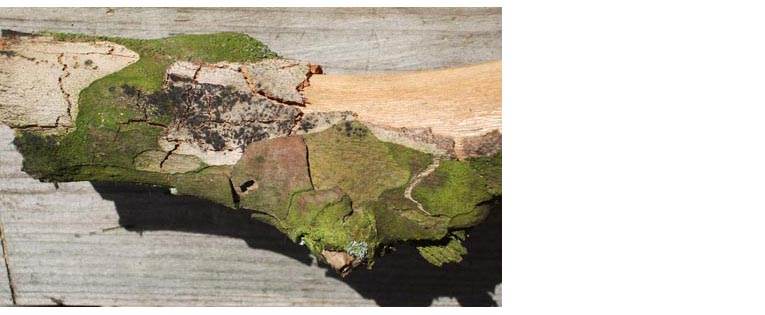
A small branch 2.5 cms in diameter at the break point with typical Massaria black
spotting, orange colour of exposed wood and damaged bark.
The disease appears on the upper side of the branch, close to its base or often mid-way along its length, where a fungal attack takes hold. At the beginning, the disease shows as a long pink-brown strip, later brown and finally black with spores. It has a clearly delimited area where it attacks the bark and cell tissues of the branch and subsequently the wood rots, becoming dry and soft and losing its strength.
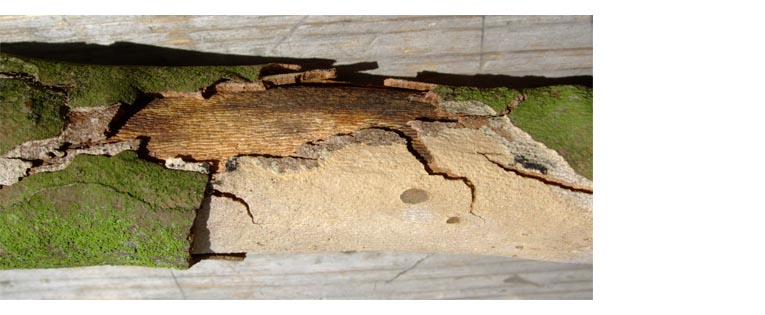
A piece of a branch 4 cms in diameter showing the layers of bark that have been penetrated and
killed by the fungus. Normally, only small patches of the outer bark are shed as part of the
plane's natural growth; here the green outer bark is shown separated from the cream-coloured
inner bark which in turn has peeled to show the sapwood which has turned orange/brown as a
result of Massaria.
Because the fungal attack is sited on the upper side of branches it is largely impossible to see it in living branches from the ground, whereas dead branches may show their dead, flaking bark and an orange colour to the surface of the wood underneath the bark. Fallen branches may show fine, white fungal filaments, discolouration of the wood from pink to brown to sooty black with spores and, if not already dried out, a clearly defined area of paler or greyish decay will be seen in a cross section of the wood.
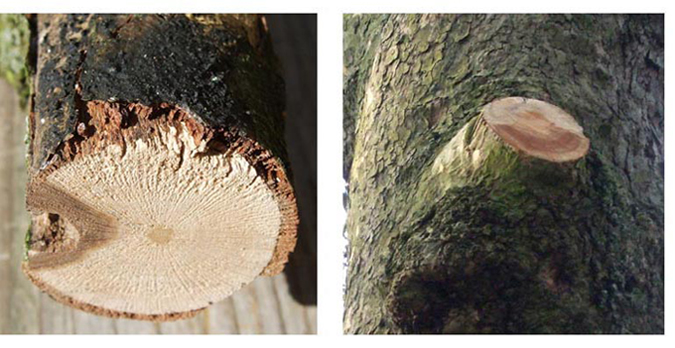
Cross-section of the 2.5 cms diameter branch showing dessicated, rotted wood just below the site of the
Massaria attack, (left), and of the stump of a substantial branch removed from a tree at Highbury Fields,
showing the clearly defined pale area of fungal damage to the wood, (right).
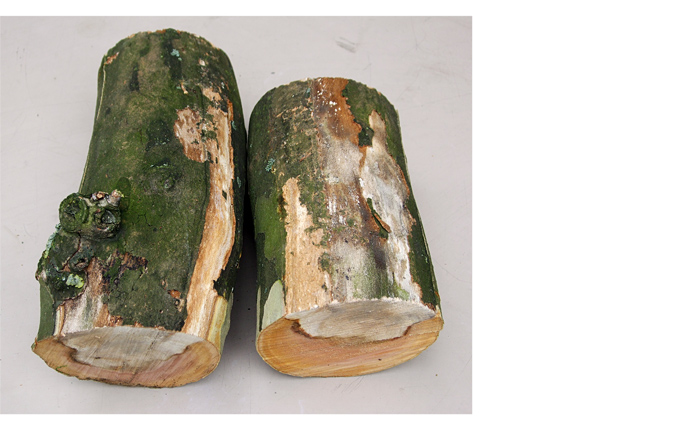
Sections from two branches, each 11 cms in diameter, from Coram Fields,
Bloomsbury, WC1, June 2011. Both branches were alive and in leaf; the sample
on the left shows clearly the difficulty of identifying Massaria without climbing
into the tree. At this relatively early stage in the decline of the branch, the bark
in this section shows little damage above the infected area although the fungus
has penetrated deep into the living wood.
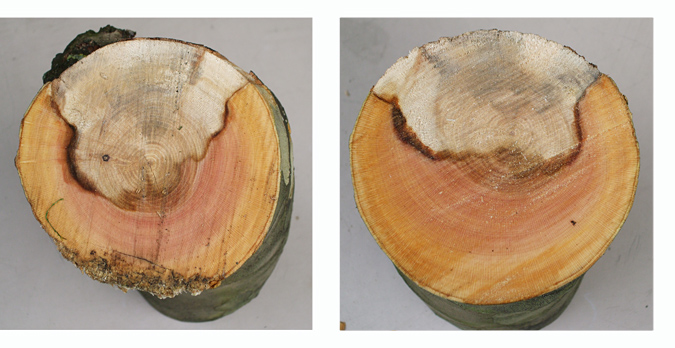
Photos showing both ends of the log on the left in the photo above. Because the fungus rots the wood (the
rot shows in the pale areas of the cross-sections), progressive weakening of the structure of the wood as
the fungus extends its area would lead to the branches splitting off.
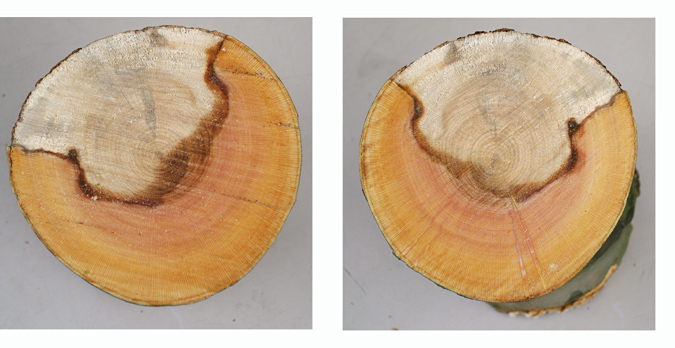
Photos showing both ends of the log on the right in the photo above. Tree surgeons have now attended to
all the trees at Coram Fields and it is planned to survey the trees again in a few months time.
The disease is a microfungus which has been known for more than 100 years as a mostly harmless coloniser of dead, fine twigs or as playing a role in the natural shedding of branches by infecting the weaker ones. Now the fungus appears to have changed into an aggressive species, attacking good, strong branches in the lower crown area as well as weaker and smaller ones, and particularly following a period when a tree has been stressed by long dry spells and high temperatures. Investigations in continental Europe suggest the disease shows a relationship between its intensity and the site and nutrition factors (increased intensity on dry sites with reduced rooting area).
It is thought that a tree stressed by dry conditions concentrates on sending the water resources it can find to the leafiest and most productive branches. The lower, more horizontal branches that have fewer leaves are less useful to the tree and are downgraded by the tree and have less water channeled to them along the branch. This, in turn, may be the trigger for existing but dormant Massaria to become active. If this is the case, it may explain why in continental Europe, planes in larger parks have been less affected than street trees. There may have been a particular problem for trees in 2011 because little if any rain fell from the beginning of the year, and a hot, dry spring followed by a dry summer and autumn probably created exceptionally challenging conditions. The disease is able to cause breakage of branches quite swiftly after infection, say within three to four months. It is exceptionally uncommon for a tree to die as a result of the disease and response to the disease does not require felling, only the removal of the infected branch. And its safe disposal in a manner that does not inadvertently spread fungal spores into the atmosphere).
Spotting Massaria from the ground
Difficult as it may be to spot Massaria when looking up into a tree, there are signs to look for. Islington's tree officers have pointed out dead branches still showing the previous year's pendant fruits, dry and brown, as evidence of the action of Massaria. Rather differently, a branch may show as dead with peeling bark exposing an orange under-surface for some of it's length but still having green leaves at the extremity of the branch. It is as good as impossible to note the start of the infection - a pink streak - which is out of view on the top surface of the branch, generally somewhere in the middle third of its length. This can develop rapidly and where tree officers know the last time a branch was recorded as healthy, seven weeks later that branch was dead, pictured below. Regular monitoring of the trees is a must to keep up with the disease.
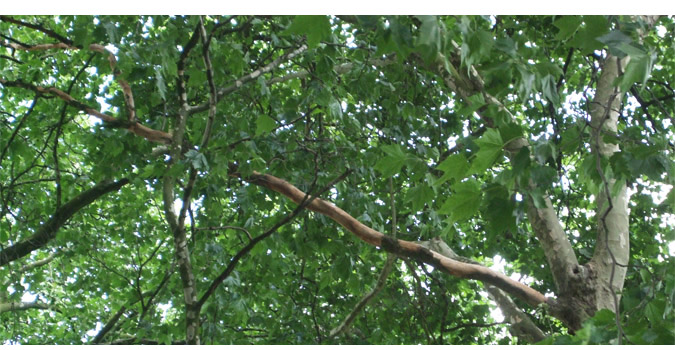
The branch with distinctive orange-coloured surface, in the centre of the photo above, has died within a
seven-week period.
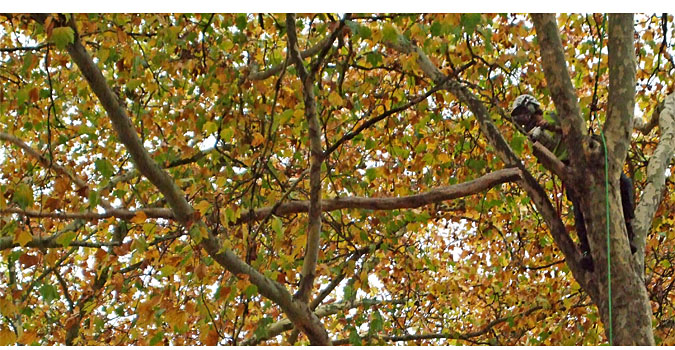
The branch, here seen falling, was removed at the end of October.
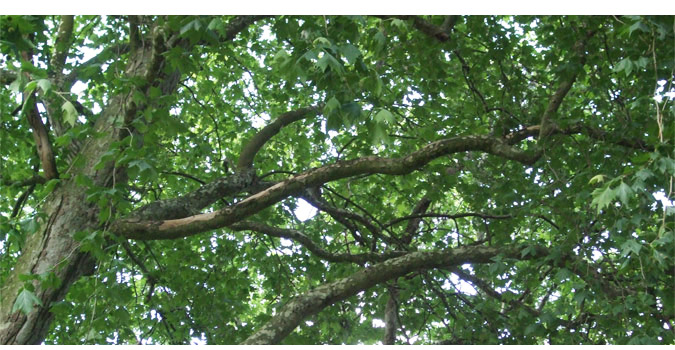
This lateral branch in the centre of the photo is dying; bark has fallen away near the stem of the tree exposing
the wood underneath, but the bark and leaves are still alive at the other end of the branch. 8 June 2011.
The challenge Massaria lays down
The major challenge is for the local authority; just the possibility of sudden breakage of branches in itself creates big problems as every plane tree must be inspected regularly to ensure emerging infection is identified. Islington's tree officers are working on this problem and will be offering training this year to Islington Tree Wardens as the plane trees come into leaf. The London Tree Officers Association has formed a working party on the disease and on a response to it.
Early detection of infected branches is the main focus in reducing the risk of accidents to people and property. This requires trained personnel because early stages of the disease are not easy to identify, and inspection of plane trees has to be repeated regularly, perhaps as frequently as every two to three months in hot, dry weather. Vehicles with platforms or tree climbers with ropes are needed but it is hoped that eventually cheaper, photographic methods may be developed. Infected branches should be removed immediately and the tree should be checked afterwards at least once a year if not more frequently.

Parts of a branch cut from a plane beside Highbury Place in December 2012 as part of the third inspection in the second year of managing Massaria in Islington. There does not seem to have been as much damage from the disease in this year; nonetheless, severely affected branches such as this example have been located and removed.
There are no fungicides available against this disease. Young plane trees should be well-watered for many years and should be given nutritious soil conditions and an adequate supply of water. Mature trees may benefit from a watering and mulching regime, too, and trials have commenced at Highbury Fields seeking to demonstrate whether success can be achieved in limiting the extent and impact of Massaria on individual trees.
These initial trials will last for 15 months; they will concentrate on a few plane trees and will involve innovative small-scale pruning to encourage growth of their crowns; the application of a liquid fertiliser, a specially prepared compost ’tea‘, to strengthen root activity and the roots’ interaction with beneficial micorrhizal fungi; and mulching to help aerate the soil and encourage worms to draw down nutrients to improve the soil and counteract some of the effects of compaction. Islington’s trials are being undertaken in association with Treework Environmental Practice and City Suburban Tree Surgeons and will be a first of their kind.
Massaria and the future for London plane trees
Massaria attacks small, weak branches and helps the tree by cleaning them away; its attacks on branches a little larger do not disfigure the tree; when larger branches are attacked there is potential for the necessary removal of visually important branches making a tree unbalanced or reduced in height and destroying its beauty and amenity benefit.
However, we understand the future for plane trees is not all bad. Despite the many problems experienced over recent years in Germany and Switzerland, where half a town's plane trees may be infected, plane trees are still being planted in those countries. An exceptional project is taking place this year in Mannheim where 222 new London planes, 7-9 metres high, are being planted to create a boulevard 1.2 Km long on a major thoroughfare into the city centre. It is a refurbishment and landscaping of the degraded Augustaanlage (Augusta Avenue), first laid out in 1907, see links below.
At the beginning of August, 2012, 138 of the 222 new plane trees had been planted in a double avenue, and works completed include new lamps, pathways and grassed areas.
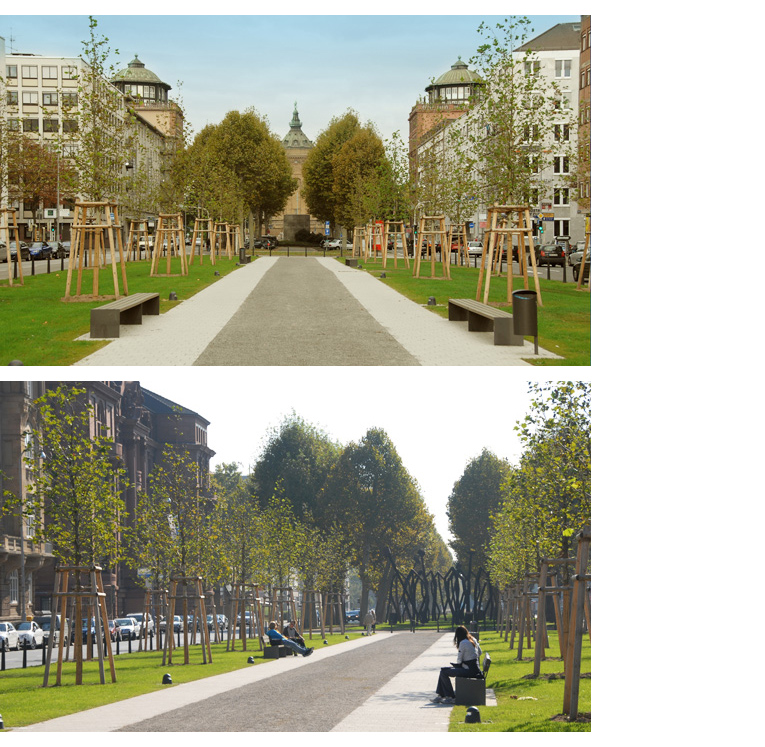
The new avenue of London plane trees along the Augustaanlage in Mannheim, the German city
where Massaria was first recognised as a serious problem. Photographs: Stadt Mannheim.
A complete series of photographs of the new planting is included in the sequence below.
http://www.augustaanlage.mannheim.de/downloads1.html
Much of the cost of the project is being funded via public subscription. Some of the history of this exceptional exercise is recorded in the links below.
http://gardeningingermany.blogspot.com/2010/02/mannheims-plane-tree-boulevard.html
http://www.liselotte-bloggt.de/2011/02/25/augustaanlage-mannheim-platanen (text in German)
In Zürich, planting of London plane trees continues and the tree officers are choosing a variant, Platanus x acerifolia 'Malburg', which they hope will be able to fend off the disease better as its branches tend to have a less horizontal growing habit than some other types of plane giving, they hope, less of a foothold to the fungus. Time will tell. Islington tree officers intend to trial this tree, too.
4 April 2011, last updated 23 December 2012.
TreeTree would welcome contributions on this subject. Anyone who has information about the way the disease is being handled in France, Spain or any other country may email info@treetree.co.uk.